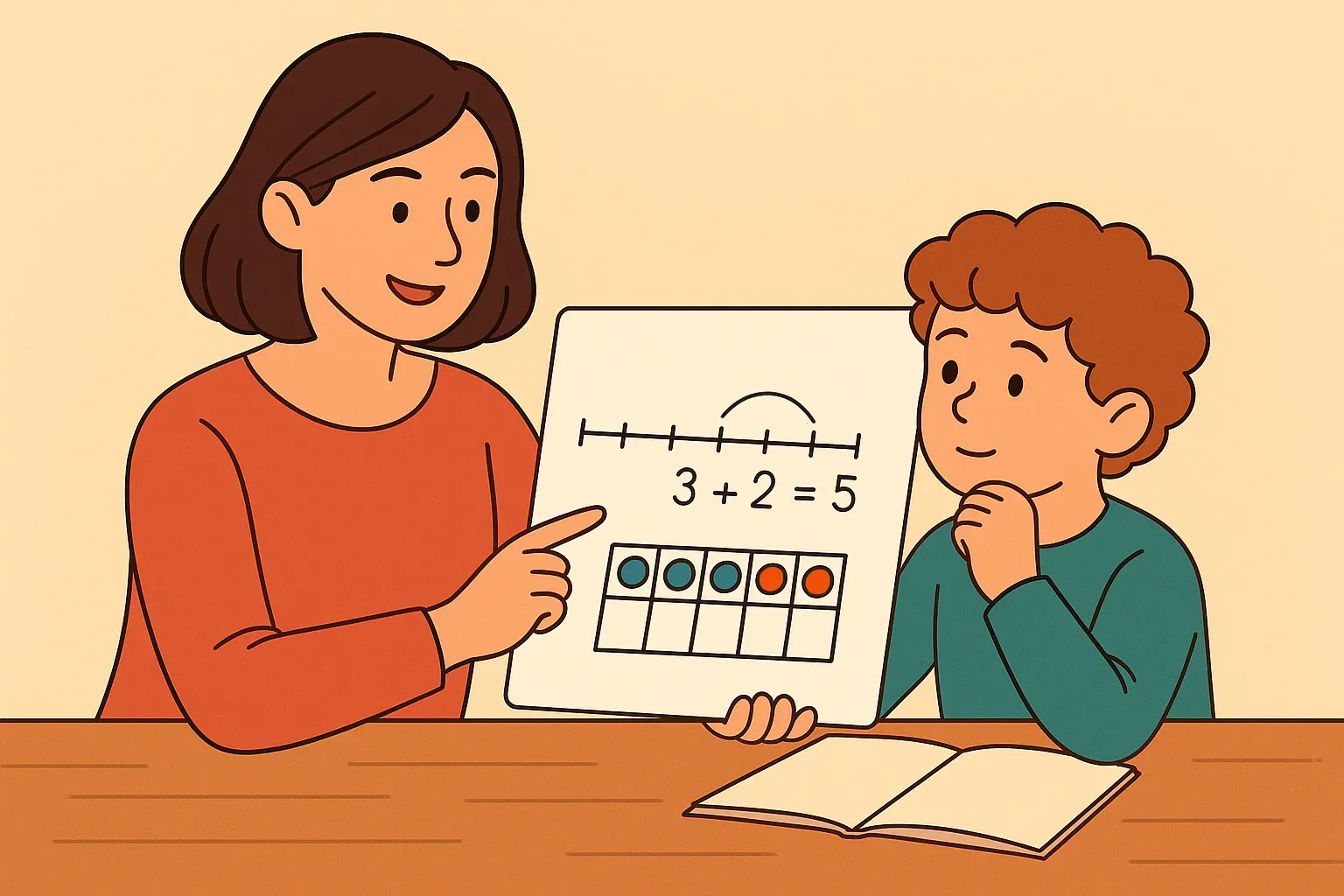Flexible Thinking in Math: Build Cognitive Switching Skills in Your Neurodivergent Child
TLDR;
Cognitive flexibility is essential for math success in neurodivergent kids. Early interventions like MILE, combined with strategies such as reflection training, play-based activities, and creative problem-solving, can significantly enhance these skills, supporting academic and personal growth. This article provides a comprehensive exploration of cognitive flexibility, its development, neural basis, and practical, evidence-based strategies for parents to support their neurodivergent children in mastering math.
Introduction
Flexible thinking, or cognitive flexibility, is the ability to adapt to new situations, shift between tasks or mental sets, and consider multiple concepts simultaneously. For neurodivergent children - those with conditions such as ADHD, autism, or learning disabilities - this skill is essential for success in mathematics.
Cognitive flexibility enables kids to approach math problems from different perspectives, experiment with alternative strategies when one fails, and recognize multiple valid solution paths. For neurodivergent children aged 5-10, who may face challenges in executive functioning, developing cognitive flexibility can significantly enhance their math performance and overall learning experience.
Cognitive Flexibility Challenges in Neurodivergent Children
Neurodivergent children often exhibit differences in executive functioning, which encompasses skills like planning, working memory, and cognitive flexibility.
For instance, children with ADHD may struggle with inhibiting impulses and sustaining attention, hindering their ability to switch tasks or consider alternative approaches. Children with autism may prefer routine and predictability, making changes or new strategies challenging. Those with learning disabilities might face difficulties processing information quickly or adapting to novel thinking patterns.
A study on children with Developmental Language Disorder (DLD) found they showed less cognitive flexibility than typically developing peers in a nonexistent object drawing (NEOD) task. While both groups performed similarly on simple changes (e.g., altering size or shape), children with DLD made fewer complex changes, such as inserting new elements or exchanging object parts, linked to lower verbal short-term memory and inhibition (Cognitive Flexibility in DLD). Similar patterns may occur in other neurodivergent conditions, underscoring the need for tailored interventions.
Developmental Trajectory of Cognitive Flexibility
Cognitive flexibility begins developing in infancy and matures through childhood and adolescence. By their first year, infants show basic executive functions, with working memory, inhibition, and cognitive flexibility emerging during preschool years. The Dimensional Change Card Sort (DCCS) task, where children switch sorting rules (e.g., color to shape), reveals that 3-year-olds often perseverate on the initial rule, while 4-year-olds can switch successfully. Task-switching abilities improve between ages 5-9, with switching maturing around age 11 and maintenance by age 15.
This development is driven by the prefrontal cortex (PFC), particularly the dorsolateral PFC, which matures into adolescence (Development of Cognitive Flexibility). A meta-analysis found that cognitive flexibility’s impact on math is stronger in younger children (r=0.40, p=0.05), highlighting early childhood as a critical intervention period (Cognitive Flexibility and Math).
Neural Basis of Cognitive Flexibility
Cognitive flexibility relies on a network of brain regions, including the prefrontal cortex (PFC), parietal cortex, basal ganglia, and subcortical structures. The PFC’s dorsolateral and ventrolateral regions are central to executive functions. Neuroimaging studies using near-infrared spectroscopy (NIRS) show that 3-year-olds activate the right inferior PFC during flexibility tasks, while 5-year-olds and adults engage both sides, indicating neural maturation. Variations in these regions’ development or functioning in neurodivergent children may contribute to flexibility challenges, necessitating targeted support (Development of Cognitive Flexibility).
Interplay with Other Executive Functions
Cognitive flexibility is intertwined with working memory and inhibition. Working memory enables holding and manipulating multiple strategies, while inhibition suppresses irrelevant impulses, aiding task-switching. Deficits in these areas can impair flexibility, as seen in children with DLD, where lower verbal short-term memory and inhibition correlated with reduced flexibility (Cognitive Flexibility in DLD). Interventions targeting multiple executive functions may thus be particularly effective for neurodivergent children.
The Link Between Cognitive Flexibility and Math Performance
Research consistently demonstrates that cognitive flexibility enhances math performance. A meta-analysis of 23 studies with over 35,000 children (mean age 5.8) found a moderate correlation (r=0.35) between cognitive flexibility and math skills, consistent across general math (r=0.35), conceptual math (r=0.34), and procedural math (r=0.33). The correlation is stronger in younger children (r=0.40, p=0.05), emphasizing the importance of early intervention for kids aged 5-10 (Cognitive Flexibility and Math). This suggests that fostering cognitive flexibility can significantly improve math outcomes for neurodivergent children.
Evidence-Based Interventions
The Math Interactive Learning Experience (MILE) is a structured intervention supporting cognitive processes like executive functions and working memory. Using a “Focus/Plan, Act, Reflect” (FAR) methodology, MILE encourages planning, action, and reflection. A quasi-experimental study with 28 children aged 5-8, many with ADHD (37%) or learning disorders (11.1%), showed significant math gains in the MILE group (M=10.5, SD=4.1) compared to controls (M=3.3, SD=3.3, t(10)=3.33, p=0.008), with 85.7% improving in at least one math area (MILE Intervention). Other interventions include:
- Metacognitive Training: Reflection training improved DCCS performance in 2-4-year-olds, reducing neural effort
- Task-Switching Training: Enhanced flexibility, inhibition, and working memory in 7-12-year-olds, including those with ADHD.
- Play-Based Activities: Games like puzzles or strategy-based video games foster flexibility naturally.
Practical Strategies for Parents
Parents of neurodivergent children aged 5-10 can foster cognitive flexibility with these detailed, evidence-based strategies. These approaches, tailored to the unique needs of children with conditions like ADHD, autism, or learning disabilities, aim to make math engaging while building the ability to switch between strategies. Each strategy is designed to be practical, adaptable, and supportive, encouraging children to approach problems creatively and confidently.
Creative Visual Aids
Visual aids are powerful tools for helping neurodivergent children see multiple ways to solve math problems, which can reduce frustration and encourage flexible thinking. Create colorful charts, diagrams, or physical manipulatives (like blocks or counters) to illustrate different strategies, such as adding numbers using a number line, grouping objects, or drawing arrays.
For example, when teaching addition, draw a chart with three columns: one for counting fingers, one for using objects like buttons, and one for a number line. Sit with your child and walk through each method, asking them to try each one and discuss which feels easiest. This not only reinforces the concept that there are multiple correct approaches but also makes abstract math concepts more concrete.

For children who may struggle with abstract thinking, such as those with autism, tactile or visual elements can be particularly effective. Rotate the types of visuals weekly to keep the activity fresh and encourage adaptability, ensuring the child doesn’t fixate on a single method.
‘What If’ Scenarios
Encouraging children to explore hypothetical scenarios can spark creative problem-solving and help them practice switching mental sets. During math activities, pose open-ended questions like, “What if we grouped these numbers differently to add them?” or “What if we used subtraction instead of addition to solve this?” For instance, if working on the problem 8 + 6, ask your child to first add directly, then try breaking it into 8 + 2 + 4 to make a “friendly” number (10 + 4). Discuss why each method works and how it feels to switch approaches. This strategy is particularly helpful for children with ADHD, who may impulsively stick to one method. To make it engaging, turn it into a game where they earn points for each new strategy they try. Start with simple problems and gradually increase complexity, ensuring the child feels successful. Over time, these scenarios build confidence in experimenting with new ideas, reducing anxiety about making mistakes.
Math Games
Strategy-based games are an enjoyable way to build cognitive flexibility, as they often require players to adapt to changing rules or conditions. Games like Uno, Connect Four, or math-focused apps (e.g., Monster Math) encourage children to think strategically and adjust their approach based on new information, such as a puzzle that becomes more difficult or a change in gameplay. For example, in Uno, a child must shift their plan when a “skip” or “reverse” card changes the game’s flow, mirroring the need to switch strategies in math. Set aside 15-20 minutes a few times a week for family game time, choosing games that align with your child’s interests.

For a child with autism who thrives on predictability, introduce games with clear rules but gradual changes, like adding a new rule after each round. Discuss the strategies used during the game, connecting them to math (e.g., “You changed your plan in the game; can we try that with this math problem?”). This approach makes flexibility fun and relatable, reinforcing its value in a low-pressure setting.
Storytelling with a Twist
Storytelling can promote perspective-taking and flexible thinking by encouraging children to consider alternative outcomes or approaches.
Read a short story or create one together, then pause at a key decision point and ask, “How would the story change if the character made a different choice?” For example, in a story about a character planning a picnic, ask, “What if it rains? How could they solve that problem?” Connect this to math by creating math-related stories, such as a character needing to share 12 apples among friends. Ask your child to propose different ways to divide the apples (e.g., equal groups, some left over) and discuss the results. This strategy works well for children with learning disabilities, as it embeds math in a narrative context, making it less intimidating. Use props or drawings to make the story interactive, especially for younger kids or those with attention challenges. Repeat this activity weekly, varying the stories to keep it engaging, and praise your child for creative ideas to build their confidence in thinking flexibly.
Math Journals
Encouraging children to keep a math journal fosters metacognition—the ability to reflect on their own thinking—while reinforcing the idea that problems can be solved in multiple ways.
After completing a math problem, ask your child to write or draw two or three different methods they used or could use to solve it. For example, for 15 – 7, they might write about counting backward, using a number line, or adding up from 7 to 15. Spend a few minutes discussing their entries, asking questions like, “Why did you choose this method?” or “How did it feel to try something new?”
For children who struggle with writing, allow them to dictate or draw their ideas, ensuring the activity is accessible. This strategy is particularly effective for neurodivergent children who benefit from structure, as the journal provides a consistent way to process and reflect. Set a goal of one journal entry per math session, and periodically review past entries to celebrate progress. Over time, this practice helps children internalize flexible thinking, making it a natural part of their problem-solving approach.
These strategies are most effective when tailored to your child’s interests, developmental level, and specific neurodivergent traits. For example, a child with ADHD might thrive with fast-paced games, while a child with autism may prefer structured visual aids. Introduce one or two strategies at a time, ensuring they feel manageable, and celebrate small successes to maintain motivation. Collaborate with your child’s teachers or therapists to align these activities with their learning goals, creating a cohesive support system. With consistent practice, these approaches can help neurodivergent children build the cognitive flexibility needed to excel in math and navigate challenges with confidence.
Strategy | Description | Example Activity |
|---|---|---|
Creative Visual Aids | Show multiple solution paths visually | Chart showing addition methods |
‘What If’ Scenarios | Explore alternative approaches | Grouping numbers differently |
Math Games | Engage in strategy-based play | Playing Uno or math apps such as Monster Math |
Storytelling | Discuss different perspectives | Changing story outcomes |
Math Journals | Reflect on multiple problem-solving methods | Recording different solutions |
More Reads
Why Your ADHD Child Freezes at Math (And It's Not Laziness!)
Struggling with Multi-Step Math? It’s Not the Numbers — It’s the Memory
FAQ
What is cognitive flexibility?
Cognitive flexibility is the ability to adapt to new situations, switch between tasks, and consider multiple solutions, enabling creative problem-solving.
Why is cognitive flexibility important for math?
It allows children to experiment with different strategies and recognize multiple correct ways to solve math problems, enhancing understanding and performance.
How can I tell if my child struggles with cognitive flexibility?
Signs include fixation on one method, difficulty with routine changes, or frustration with new approaches.
Are there specific interventions for neurodivergent children?
Yes, programs like MILE and task-switching training support cognitive processes for math learning in neurodivergent kids. What can I do at home to help my child? Use visual aids, play strategy games, encourage multiple solutions, and foster reflection through storytelling or journals.
Key Citations
- Cognitive Flexibility in Children with Developmental Language Disorder: Drawing of Nonexistent Objects
- Development and Plasticity of Cognitive Flexibility in Childhood
- The Relationship Between Cognitive Flexibility and Mathematical Performance in Children: A Meta-Analysis
- Math Abilities Among Children with Neurodevelopmental Difficulties: Understanding Cognitive Factors and Evaluating a Pilot Intervention
Conclusion
Building cognitive flexibility in neurodivergent children is a journey requiring patience and tailored strategies. Evidence-based interventions like MILE, combined with daily activities such as play, reflection, and creative problem-solving, empower parents to support their children’s math skills and overall development. By understanding each child’s unique needs and celebrating progress, parents can help neurodivergent kids thrive academically and personally.


Comments
Your comment has been submitted successfully!